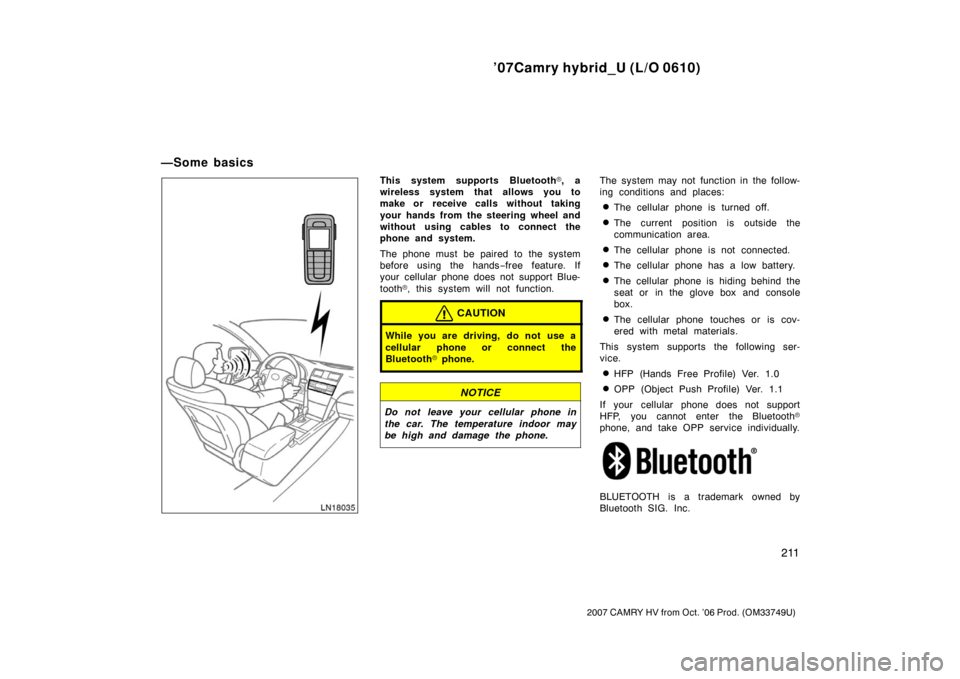Page 223 of 405

’07Camry hybrid_U (L/O 0610)
211
2007 CAMRY HV from Oct. ’06 Prod. (OM33749U)
This system supports Bluetooth�, a
wireless system that allows you to
make or receive calls without taking
your hands from the steering wheel and
without using cables to connect the
phone and system.
The phone must be paired to the system
before using the hands −free feature. If
your cellular phone does not support Blue-
tooth �, this system will not function.
CAUTION
While you are driving, do not use a
cellular phone or connect the
Bluetooth � phone.
NOTICE
Do not leave your cellular phone in
the car. The temperature indoor may
be high and damage the phone.
The system may not function in the follow-
ing conditions and places:
�The cellular phone is turned off.
�The current position is outside the
communication area.
�The cellular phone is not connected.
�The cellular phone has a low battery.
�The cellular phone is hiding behind the
seat or in the glove box and console
box.
�The cellular phone touches or is cov-
ered with metal materials.
This system supports the following ser-
vice.
�HFP (Hands Free Profile) Ver. 1.0
�OPP (Object Push Profile) Ver. 1.1
If your cellular phone does not support
HFP, you cannot enter the Bluetooth �
phone, and take OPP service individually.
BLUETOOTH is a trademark owned by
Bluetooth SIG. Inc.
—Some basics
Page 225 of 405

’07Camry hybrid_U (L/O 0610)
213
2007 CAMRY HV from Oct. ’06 Prod. (OM33749U)
CAUTION: Radio Frequency Radiation
Exposure
This equipment complies with FCC
radiation exposure limits set forth for
uncontrolled equipment and meets the
FCC radio frequency (RF) Exposure
Guidelines in Supplement C to OET65.
This equipment has very low levels of
RF energy that it deemed to comply
without maximum permissive exposure
evaluation (MPE). But it is desirable
that it should be installed and oper-
ated with at least 20 cm and more
between the radiator and person’s
body (excluding extremities: hands,
wrists, feet and legs).
Co�location: This transmitter must
not be co −located or operated in con-
junction with any other antenna or
transmitter.
Steering switches
Overhead console
1. Volume control switch
To increase the volume: Push “+”.
To decrease the volume: Push “ −”.
When driving at 80 km/h (50 mph) or
more, the volume automatically increases
without switch adjustment. When your
speed falls below 70 km/h (43 mph), the
volume automatically returns to its original
level.
Voice guidance volume can be changed by
pushing the volume control switch on the
steering wheel. 2. Talk switch
Pushing the talk switch turns the hands −
free system on and initiates the speech
command system.
Pushing and holding the talk switch ends
the speech command system.
3. Off�hook switch
Pushing the off −hook switch turns the
hands −free system on.
When receiving a call, pushing the off −
hook switch allows you to talk on the
phone.
—Control and features
� Steering switches and microphone
Page 261 of 405

’07Camry hybrid_U (L/O 0610)
249
2007 CAMRY HV from Oct. ’06 Prod. (OM33749U)
Press the “A/C” button for dehumidified
heating or cooling. This setting clears the
front view more quickly.
�To heat the vehicle interior while de-
frosting the windshield, choose
floor/windshield air flow.
Some parts of the air conditioning system
can be adjusted using the switches on the
steering wheel.
Details of the specific switches, controls,
and features are described below.1. Temperature selector (“TEMP”) (with “DUAL” button indicator
on—individual setting on driver side
only)
(with “DUAL” button indicator
off—simultaneous setting on driver and
front passenger)
2. “AUTO” button
3. “OFF” button “AUTO” button
For automatic operation of the air condi-
tioning, press the “AUTO” button. The
“AUTO” button will turn on, indicating that
the automatic operation mode has been
selected.
In the automatic operation mode, the air
conditioning selects the most suitable fan
speed, air flow, air intake and on
−off of
the air conditioning according to the tem-
perature.
When you press the “AUTO” button with
the air intake mode at FRESH, internal
circulation may be applied for maximum
cooling.
You may use manual controls if you want
to select your own settings.
Temperature selector
To increase the temperature, press the
“ � ” side. To decrease it, press the “ �”
side.
“LO” appears when you adjust to maxi-
mum cooling, and “HI” appears when you
adjust to maximum warming.
With the “DUAL” button indicator on—This
button changes the temperature on the
driver side only.
Climate remote controls
(steering switches)
Page 294 of 405

’07Camry hybrid_U (L/O 0610)
282
2007 CAMRY HV from Oct. ’06 Prod. (OM33749U)
CAUTION
�Do not pump the brake pedal if the
hybrid system is not operating.
Each push on the pedal uses up
your reserved brake fluid pressure.
�Even if the power assist is com-
pletely lost, the brakes will still
work. But you will have to push the
pedal hard, much harder than nor-
mal. And your braking distance will
increase.
DRUM�IN�DISC TYPE PARKING BRAKE
SYSTEM
Your vehicle has a drum−in −disc type
parking brake system. This type of brake
system n eeds bedding −down of the brake
shoes periodically or whenever the parking
brake shoes and/or drums are replaced.
Have your Toyota dealer perform the bed-
ding− down. Driving conditions where the steering
wheel must be turned frequently may
cause an overload to the electric power
steering system. The system will reduce
assistance for sometime to prevent the
power steering from overheating. In this
case, you may feel some resistance when
turning the steering wheel though it is not
a malfunction.
CAUTION
If the “P/S” warning light comes on,
take your vehicle to the Toyota dealer
as soon as possible. In this case, you
may feel the heavy steering wheel
maneuvering. Drive your vehicle while
gripping the steering wheel firmly.
The brake pad wear limit indicators on
your disc brakes give a warning noise
when the brake pads are worn to where
replacement is required.
If you hear a squealing or scraping noise
while driving, have the brake pads
checked and replaced by your Toyota
dealer as soon as possible. Expensive ro-
tor damage can result if the pads are not
replaced when necessary.
Electric power steering system
Brake pad wear limit
indicators
Page 301 of 405
’07Camry hybrid_U (L/O 0610)
289
2007 CAMRY HV from Oct. ’06 Prod. (OM33749U)
This illustration indicates typical tire
size.1. Tire use (P=Passenger car, T=Temporary use)
2. Section width (in millimeters)
3. Aspect ratio (tire height to section width)
4. Tire construction code (R=Radial, D=Diagonal)
5. Wheel diameter (in inches)
6. Load index (2 digits or 3 digits)
7. Speed symbol (alphabet with one letter)1. Section width
2. Tire height
3. Wheel diameter1. Bead
2. Sidewall
3. Shoulder
4. Tread
5. Belt
6. Inner liner
7. Reinforcing rubber
8. Carcass
9. Rim lines
10.Bead wires
11. Chafer
—Tire size —Name of each section of tire
Page 303 of 405

’07Camry hybrid_U (L/O 0610)
291
2007 CAMRY HV from Oct. ’06 Prod. (OM33749U)
Temperature A, B, C—T he tem per a-
ture grades are A (the highest), B,
and C, representing the tire’s resis-
tance to the generation of heat and
its ability to dissipate heat when
tested under controlled conditions on
a specified indoor laboratory test
wheel. Sustained high temperature
can cause the material of the tire to
degenerate and reduce tire life, and
excessive temperature can lead to
sudden tire failure. The grade C cor-
responds to a level of performance
which all passenger car tires must
meet under the Federal Motor Vehicle
Safety Standard No.109. Grades B
and A represent higher levels of per-
formance on the laboratory test wheel
than the minimum required by law.
Warning: The temperature grades for
this tire are established for a tire that
is properly inflated and not over-
loaded. Excessive speed, underinfla-
tion, or excessive loading, either sep-
arately or in combination, can cause
heat buildup and possible tire failure.
Page 305 of 405

’07Camry hybrid_U (L/O 0610)
293
2007 CAMRY HV from Oct. ’06 Prod. (OM33749U)
Ti r e relat ed ter mMeaning
Normal occupant weight68 kg (150 lb.) times the number of occupants specified in the second
column of Table 1 that follows
Occupant distributiondistribution of occupants in a vehicle as specified in the third column of Table
1 that follows
Production options weight
the combined weight of those installed regular production options weighing
over 2.3 kg (5 lb.) in excess of those standard items which they replace,
not previously considered in curb weight or accessory weight, including
heavy duty brakes, ride levelers, roof rack, heavy duty battery, and special
trim
Recommended inflation pressurecold tire inflation pressure recommended by a manufacturer
Rima metal support for a tire or a tire and tube assembly upon which the tire beads
are seated
Rim diameter (Wheel diameter)nominal diameter of the bead seat
Rim size designationrim diameter and width
Rim type designationthe industry of manufacturer ’s designation for a rim by style or code
Rim widt hnominal distance between rim flanges
Vehicle capacity weight
(Total load capacity)the rated cargo and luggage load plus 68 kg (150 lb.) times the vehicle’s desig-
nated seating capacity
Vehicle maximum load on the tirethe load on an individual tire that is determined by distributing to each axle
its share of the maximum loaded vehicle weight and dividing by two
Page 310 of 405

’07Camry hybrid_U (L/O 0610)
298
2007 CAMRY HV from Oct. ’06 Prod. (OM33749U)
CAUTION
Even if the total load of occu-
pant’s weight and the cargo load
is less than the total load capac-
ity, do not apply the load uneven-
ly. That may cause not only dam-
age to the tire but also deteriora-
tion to the steering ability due to
unbalance of the vehicle, causing
an accident.
Determine what kind of tires your
vehicle is originally equipped with.1. Summer tires
Summer tires are high −speed capabil-
ity tires best suited to highway driving
under dry conditions.
Since summer tires do not have the
same traction performance as snow
tires, summer tires are inadequate for
driving on snow −covered or icy roads.
For driving on snow −covered or icy
roads, we recommend using snow
tires. If installing snow tires, be sure
to replace all four tires.
2. All season tires
All season tires are designed to pro-
vide better traction in snow and to be
adequate for driving in most winter
conditions, as well as for use all year
round. All season tires, however, do not have
adequate traction performance
compared with snow tires in heavy or
loose snow. Also, all season tires fall
short in acceleration and handling
performance compared with summer
tires in highway driving.
The details about how to distinguish
summer tires from all season tires are
described on page 285.
CAUTION
�
Do not mix summer and all sea-
son tires on your vehicle as
this can cause dangerous han-
dling characteristics, resulting
in loss of control.
� Do not use tires other than the
manufacturer’s designated
tires, and never mix tires or
wheels of the sizes different
from the originally equipped
tires and wheels.
Types of tires